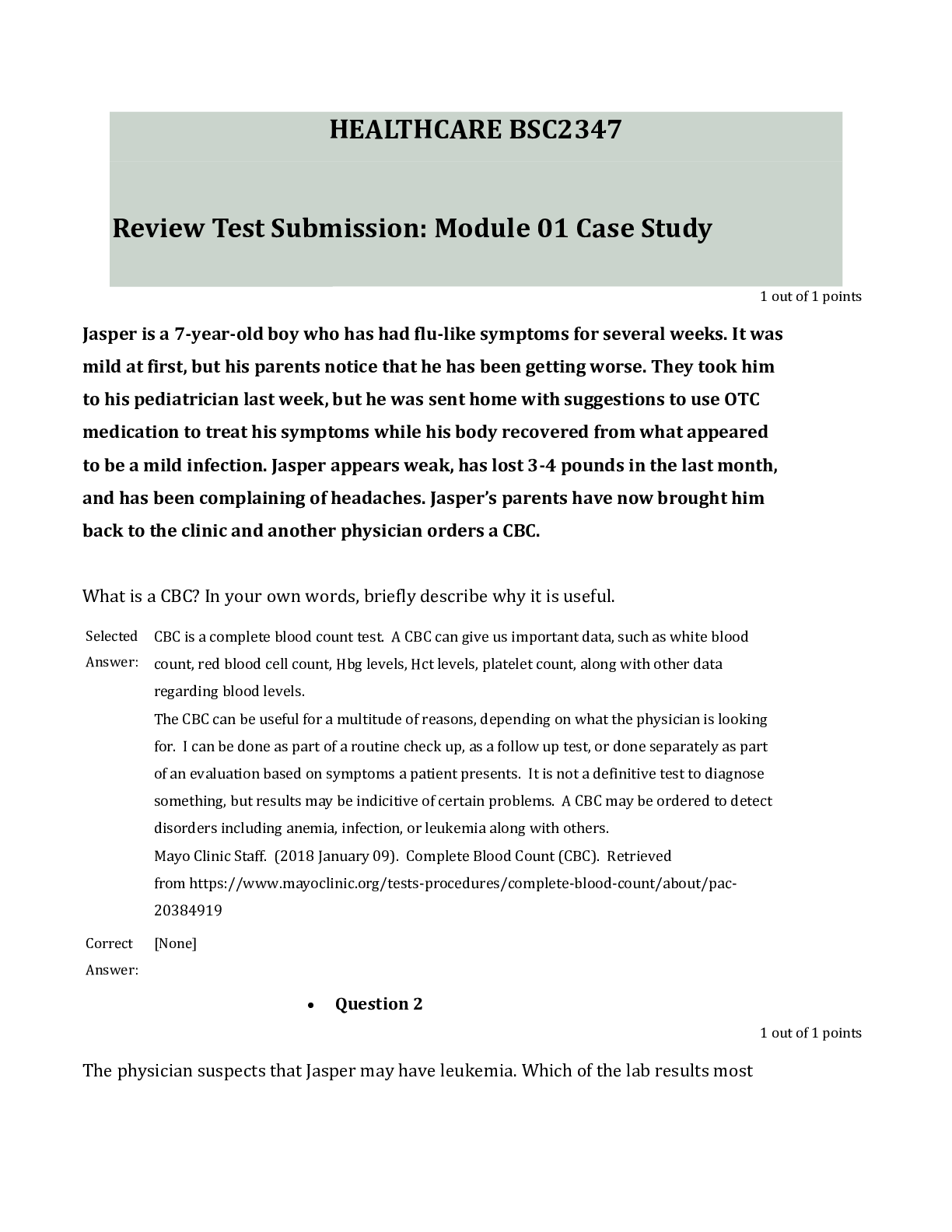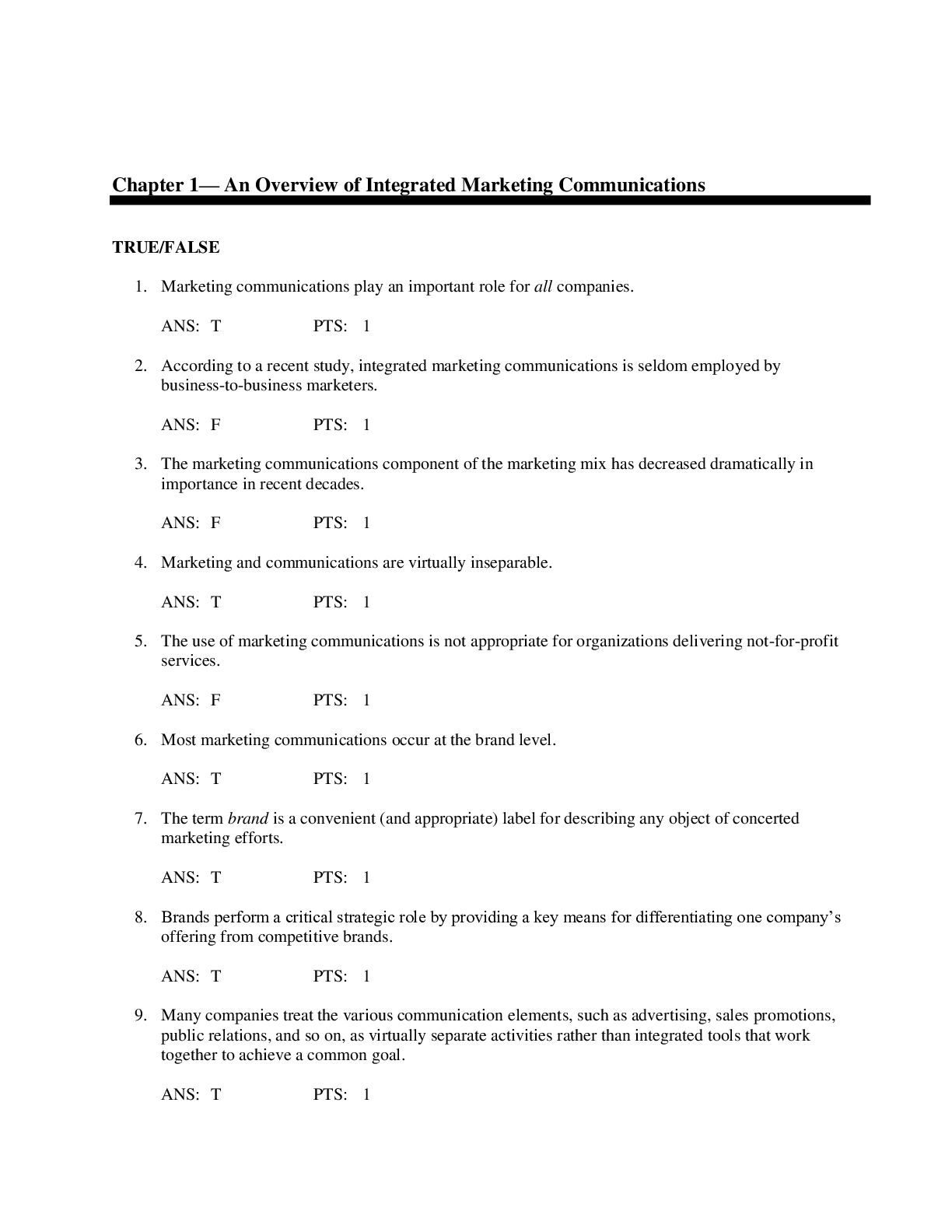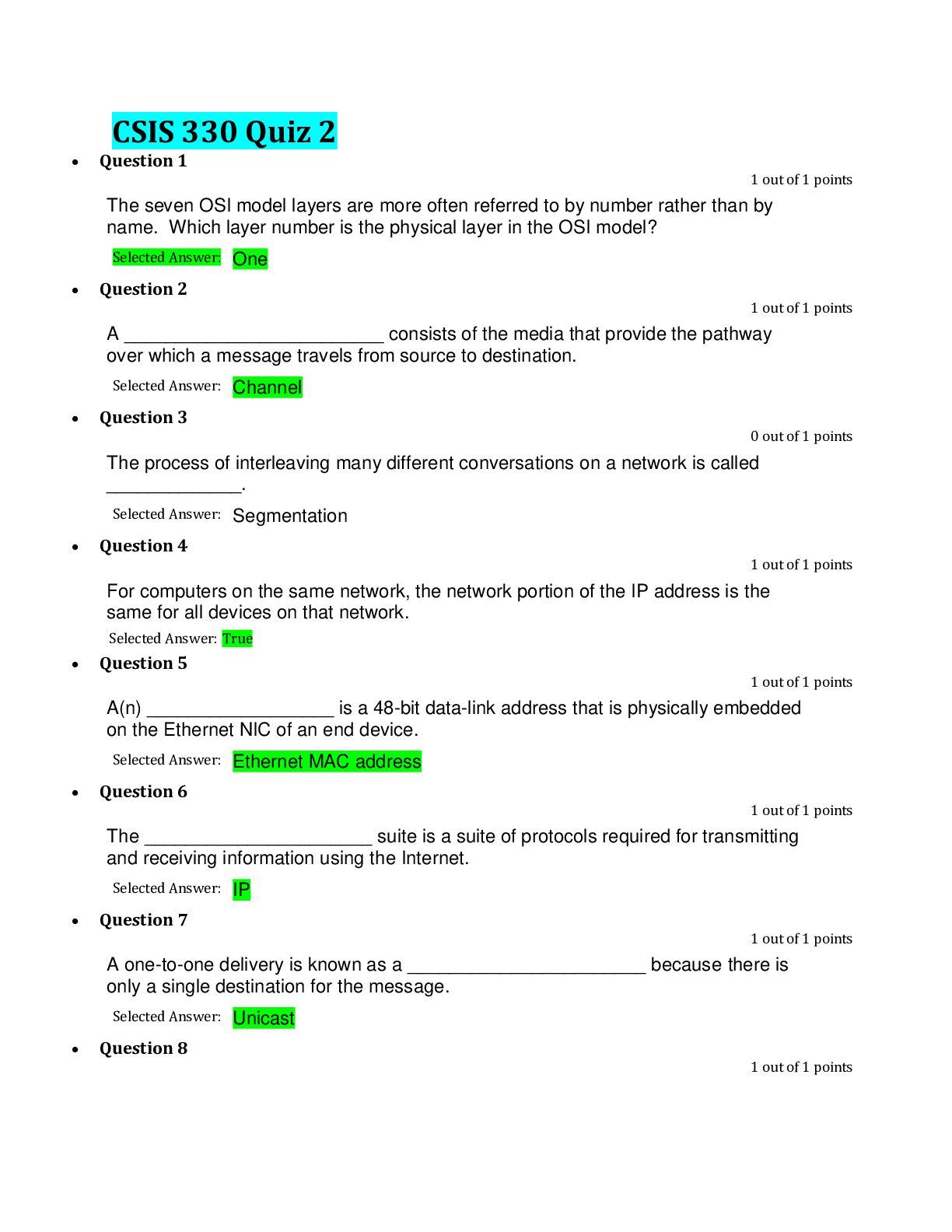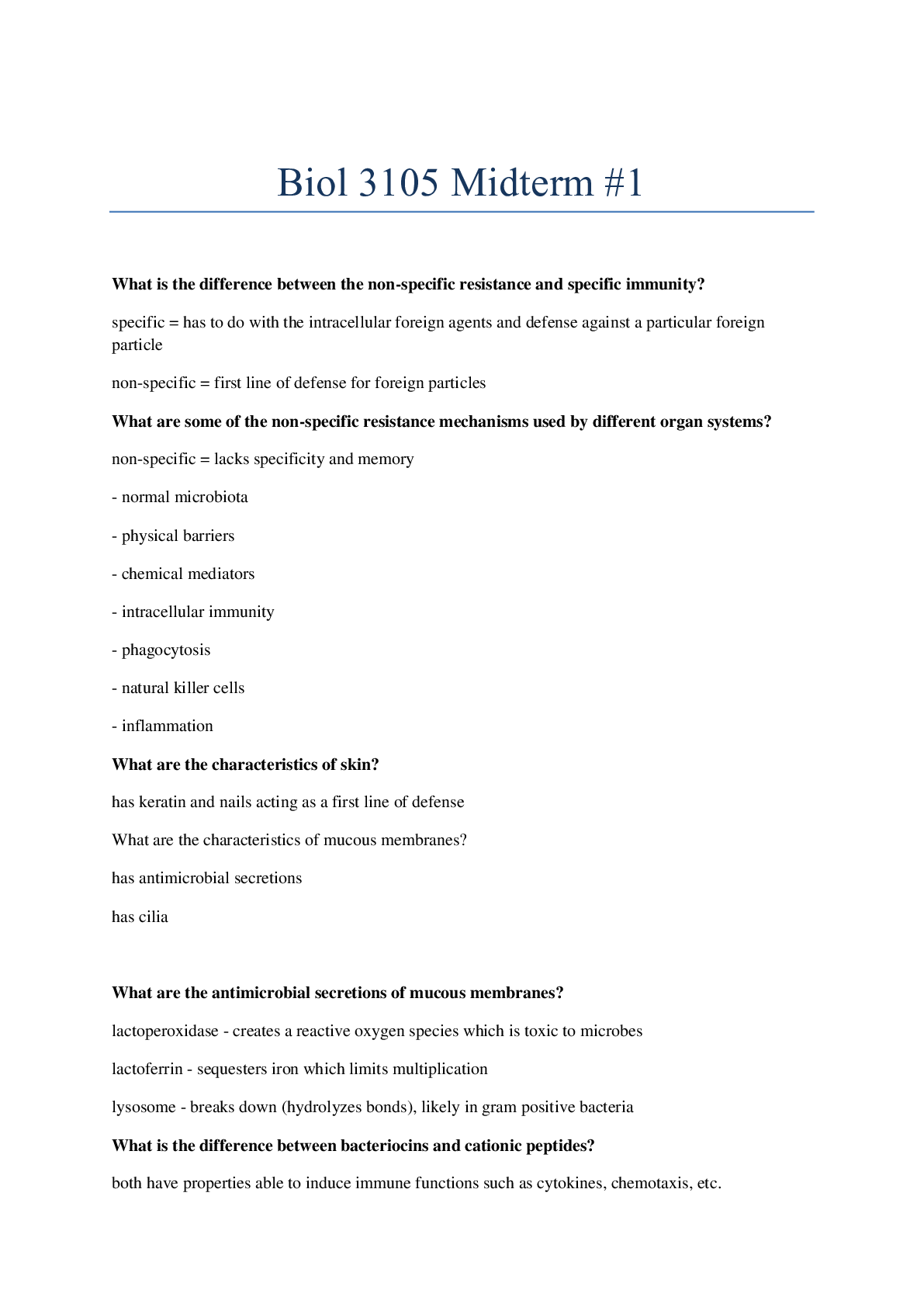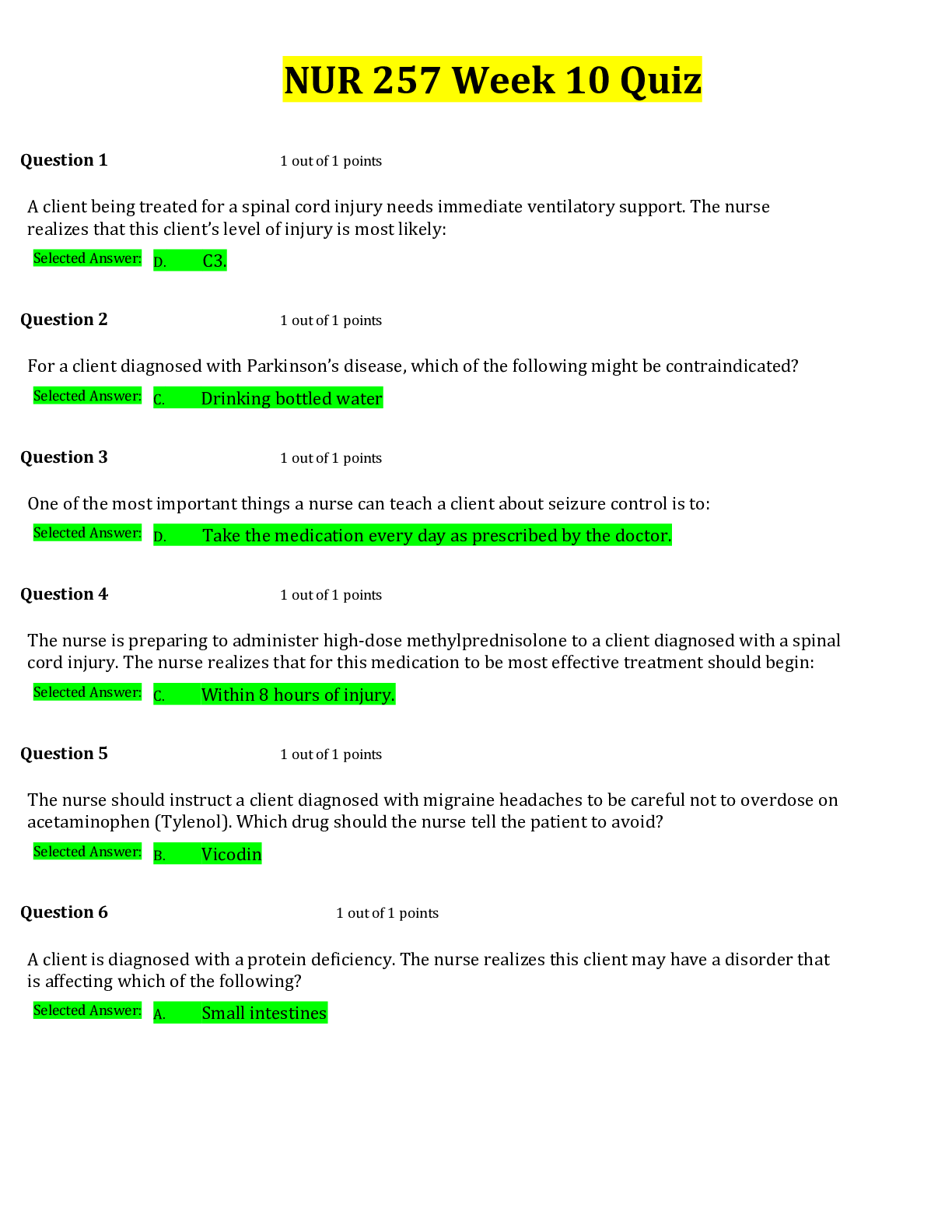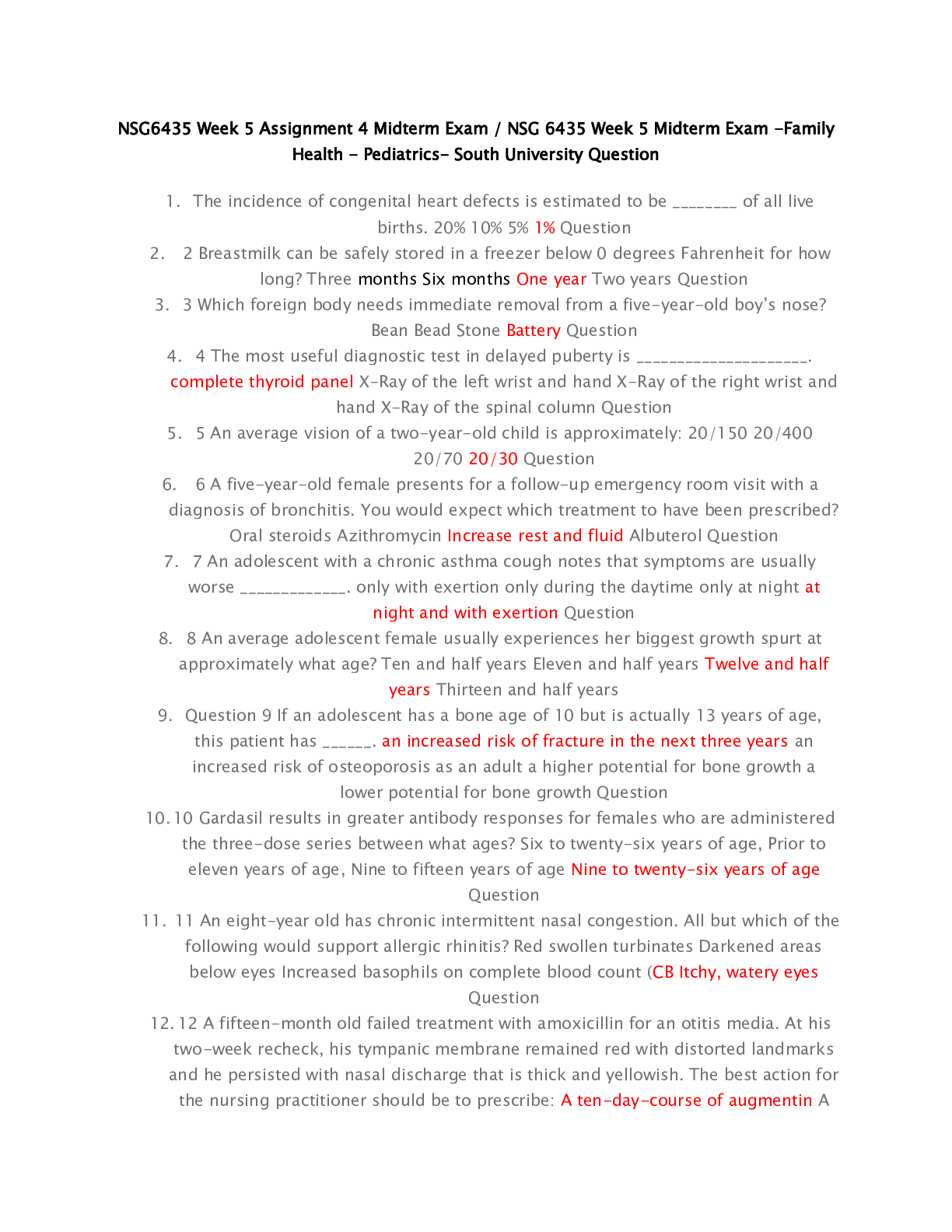Accounting > QUESTIONS & ANSWERS > Daytona State College - ACG 2071Chapter 1,2,3,4 Quiz. All Answers Correct (All)
Daytona State College - ACG 2071Chapter 1,2,3,4 Quiz. All Answers Correct
Document Content and Description Below
Question 1 (1 point) Which school of jurisprudential thought emphasizes using law as a tool for market efficiency while solving legal disputes? Question 1 options: the Sociological School of... jurisprudence the Command School of jurisprudence the Critical Legal Studies School of jurisprudence the Law and Economics School of jurisprudence Save Question 2 (1 point) What was the key reason for the creation of law courts during the early development of the English common law? Question 2 options: to administer law in a uniform manner to facilitate legal disputes for the wealthy and influential to help merchants form a standardized set of commercial laws to increase the power of the king in law-making Save Question 3 (1 point) The Law and Economics School believes that legal decision making should be functional to market efficiency. Question 3 options: True False Save Question 4 (1 point) A treaty does not require Senate approval before being passed. Question 4 options: True False Save Question 5 (1 point) Ordinances are not codified into code books. Question 5 options: True False Save Question 6 (1 point) The Securities and Exchange Commission (SEC), created by the Congress to enforce federal securities laws, is an example of a(n) ________. Question 6 options: intelligence agency congressional body administrative agency judicial body Save Question 7 (1 point) What is considered as the supreme law of the land in the United States? Question 7 options: the Constitution of the United States of America the federal statutes passed by the United States Congress judicial decisions issued by the state courts executive orders passed by the president Save Question 8 (1 point) Federal statutes are organized by topic into code books. Question 8 options: True False Save Question 9 (1 point) Treaties are considered to be part of the supreme law of the United States of America. Question 9 options: True False Save Question 10 (1 point) Executive orders are an example of codified law. Question 10 options: True False Question 1 (1 point) Within a state, the state constitution precedes the U.S. Constitution. Question 1 options: True False Save Question 2 (1 point) Federal statutes take precedence over federal regulations. Question 2 options: True False Save Question 3 (1 point) Natural Law School of jurisprudence emphasizes shaping laws based on morals and ethics. Question 3 options: True False Save Question 4 (1 point) According to the priority of law in the United States, which of the following statements is true? Question 4 options: State laws take precedence over the U.S. Constitution within that state. Valid state laws take precedence over any conflicting federal laws. Valid state laws take precedence over local laws. State regulations take precedence over state statutes. Save Question 5 (1 point) The merchant courts were established because of the unfair results and limited remedies available in the chancery courts. Question 5 options: True False Save Question 6 (1 point) Provisions of federal law are valid as long as they do not conflict with any state law. Question 6 options: True False Save Question 7 (1 point) Laws in the U.S. are not set to evolve with changes in social norms. Question 7 options: True False Save Question 8 (1 point) What led to the creation of the Chancery Courts? Question 8 options: the increase in overseas trade and proliferation of piracy the unfair results and limited remedies provided by the law courts the insistence for a court system that emphasized legal procedure rather than the merits of a case the law courts' inability to hear all the cases presented to them Save Question 9 (1 point) Statutes are written laws that establish certain courses of conduct that covered parties must adhere to. Question 9 options: True False Save Question 10 (1 point) The Analytical School of jurisprudence lays emphasis on how the result of a case is reached rather than the logic of the result itself. Question 10 options: True False Question 1 (1 point) The Analytical School of jurisprudence maintains that the law is ________. Question 1 options: based on social behavior set by the ruling class based on morality shaped by logic Save Question 2 (1 point) Businesses that are organized in the United States are subject to its laws, but not to the laws of other countries in which they do business. Question 2 options: True False Save Question 3 (1 point) How is legal precedent used between courts of different states? Question 3 options: Courts of a state must follow precedent from courts of another state for similar cases. Courts of a state can use precedent from courts of another state as a form of guidance. Courts of a state cannot challenge the precedence of courts of another state. Courts of a state cannot cite the judicial decisions of courts of another state in its decisions. Save Question 4 (1 point) Ordinances are codified laws that are issued by ________. Question 4 options: the state legislature the Supreme Court judges local government bodies the president Save Question 5 (1 point) Which school of jurisprudential thought is reflected in documents such as the U.S. Constitution, the Magna Carta, and the United Nations Charter? Question 5 options: the Historical School the Analytical School the Sociological School the Natural Law School Save Question 6 (1 point) The law courts of the English common law could only provide monetary awards for damages. Question 6 options: True False Save Question 7 (1 point) Statutes are enacted by Congress and state legislatures. Question 7 options: True False Save Question 8 (1 point) State courts of one state are not required to follow the legal precedent established by the courts of another state. Question 8 options: True False Save Question 9 (1 point) Statutesare written laws that establish certain courses of conduct that covered parties can use as a form of guidance. Question 9 options: True False Save Question 10 (1 point) Stare decisis is the doctrine of ________. Question 10 options: separating powers between state and religion ensuring all legal rights are provided to a person when otherwise deprived of them adhering to legal precedent providing proof to assert a fact in court CHAPTER 2 Question 1 (1 point) Where a long-arm statute is present, a defendant need not have minimum contact with a state for that state's courts to have jurisdiction over the defendant. Question 1 options: True False Save Question 2 (1 point) Jill wins a lawsuit against Terry in the Wyoming state court. The court passes a judgment for Terry to pay $20,000 to Jill. Immediately after the case is settled, Terry moves to Colorado, where she owns a house, and refuses to pay Jill the money. Which of the following is the best course of action for Jill? Question 2 options: file a case against Terry in Wyoming to force Terry to sell her house in Colorado to pay the money file a lawsuit against Terry in a Colorado state court to enforce the Wyoming court judgment file a case in the Colorado federal court as this qualifies as a federal question case file another case against Terry in the Wyoming state court to collect the money against Terry's property Save Question 3 (1 point) ________ refers to jurisdiction that allows a plaintiff who obtains a judgment in one state to try to collect the judgment by attaching property of the defendant located in another state. Question 3 options: Quasi in rem jurisdiction Private jurisdiction In rem jurisdiction In personam jurisdiction Save Question 4 (1 point) Which of the following courts was created by Article III of the U.S. Constitution? Question 4 options: the U.S. Court of Federal Claims the U.S. Court of Appeals the U.S. Supreme Court the U.S. Tax Court Save Question 5 (1 point) The ________ hears cases brought against the United States. Question 5 options: U.S. Court of Federal Claims U.S. Tax Court U.S. District Court U.S. Supreme Court Save Question 6 (1 point) ________ hears appeals from trial courts. Question 6 options: A court of record An inferior trial court The highest state court An intermediate appellate court Save Question 7 (1 point) Altonvista Inc., a company based in California, is sued by a plaintiff from the state of Texas. Which of the following statements would apply to this situation? Question 7 options: The case can only be heard in a California state court as the matter is not subject to federal jurisdiction. The case must be heard in the California federal court as this is a subject matter in which federal courts have exclusive jurisdiction. If the plaintiff decides to bring the case to the California federal court, Altonvista Inc. can have the case moved to a California state court. If the plaintiff chooses to bring the case to the California federal court, it would stay in the federal court. Save Question 8 (1 point) ________ are courts that hear cases of a general nature that are not within the jurisdiction of limited-jurisdiction trial courts. Question 8 options: Inferior trial courts Courts of record State supreme courts Intermediate appellate courts Save Question 9 (1 point) Intermediate appellate courts review new evidence or testimony that was not seen or heard in the lower courts. Question 9 options: True False Save Question 10 (1 point) The decisions of the U.S. Supreme Court can be appealed to higher courts. Question 10 options: True False CHAPTER 3 Question 1 (1 point) The complaint and summons are served on the plaintiff. Question 1 options: True False Save Question 2 (1 point) The term ________ refers to the oral testimony given by a party or witness prior to trial. Question 2 options: class action interrogatory intervention deposition Save Question 3 (1 point) What are jury instructions? Question 3 options: instructions to the jury from both parties over the duration within which the case has to be settled instructions to inform the jury about what law to apply when they decide the case instructions from jury informing the judge on what grounds the case can be dismissed instructions from the jury to the plaintiff's attorney about settling a case before trial Save Question 4 (1 point) What is direct examination? Question 4 options: inspection and verification of all documents related to a trial by the judge inspection and verification of all documents related to a trial by the jurors prospective jurors being questioned by the judge or lawyers of each party witnesses being questioned by the plaintiff's attorney Save Question 5 (1 point) The process of bringing, maintaining, and defending a lawsuit is generally referred to as litigation. Question 5 options: True False Save Question 6 (1 point) A pretrial motion is made to try and dispose of all or part of a lawsuit prior to trial. Question 6 options: True False Save Question 7 (1 point) Rita Fuller and Robert Morgan are contending parties to a lawsuit involving the division of their inheritance from their grandmother. They wish to settle their case out of court. Rita and Robert engage in discussions and bargaining with the presence of their attorneys and finally conclude that Robert keeps 60 percent of the inheritance while Rita gets the remainder. In this scenario, the ________ method of alternative dispute resolution is used. Question 7 options: mini-trial negotiation arbitration mediation Save Question 8 (1 point) Interventions are written questions submitted by one party to a lawsuit to the other party. Question 8 options: True False Save Question 9 (1 point) Which of the following statements best represents the distinction between binding and nonbinding arbitration? Question 9 options: Unlike nonbinding arbitration, binding arbitration takes place at a court, in the presence of a judge. A nonbinding arbitration takes place at a court, in the presence of the jury. If the arbitration is nonbinding, the decision and award of the arbitrator can be appealed to the courts. A nonbinding arbitration implies that the arbitrator's decision must be reinforced by the courts. Save Question 10 (1 point) Motions for summary judgment are supported by evidence outside of the pleadings. Question 10 options: True False Save CHAPTER 4 Question 1 (1 point) The United States considers Native American tribes as "domestic dependent" nations with limited sovereignty. Question 1 options: True False Save Question 2 (1 point) The legislative branch of the U.S. federal government is ________. Question 2 options: monocameral polycameral bicameral tricameral Save Question 3 (1 point) Which of the following statements is true about states' police power? Question 3 options: The states are given the authority to enact laws that regulate the conduct of business. Police power restricts states from regulating inter-state commerce, although it happens within their borders. The states are allowed to regulate army activities within their borders. The police force of a state is controlled by the federal police department. Save Question 4 (1 point) Why have checks and balances been built into the U.S. Constitution? Question 4 options: to prevent any one of the three branches of the government from becoming too powerful to ensure that people of all races and ethnicities are uniformly represented to keep a check on the number and frequency of amendments made to the Constitution to ensure that the judiciary is not biased or corrupt Save Question 5 (1 point) Which of the following is established by the Supremacy Clause of the U.S. Constitution? Question 5 options: The U.S. Constitution and federal treaties, laws, and regulations are the supreme law of the land. The legislative branch of the federal government is the supreme law-making authority in the country. The judiciary is the supreme law-enforcing authority and cannot be influenced by anyone, however powerful, in any manner. The president is the supreme and sovereign head of the United States. Save Question 6 (1 point) Which of the following provisions is made by the Due Process Clause? Question 6 options: Motions for amendments to the Constitution cannot be made without a majority in the House of Representatives. Violation of freedom of speech makes the violator liable for immediate prosecution with due process of the law. No state can regulate foreign trade directly or indirectly without due process of the law. No person shall be deprived of life, liberty, or property without due process of the law. Save Question 7 (1 point) The Establishment Clause guarantees that there will be no state-sponsored religion. Question 7 options: True False Save Question 8 (1 point) The president is not elected by popular vote but instead is selected by the Electoral College, whose representatives are appointed by state delegations. Question 8 options: True False Save Question 9 (1 point) The Privileges and Immunities Clause prohibits states from enacting laws that unduly discriminate in favor of their residents. Question 9 options: True False Save Question 10 (1 point) Checks and balances built into the Constitution ensure that amendments to the Constitution are not contradictory to existing laws. Question 10 options: True False Save [Show More]
Last updated: 2 years ago
Preview 1 out of 16 pages

Buy this document to get the full access instantly
Instant Download Access after purchase
Buy NowInstant download
We Accept:

Reviews( 0 )
$10.00
Can't find what you want? Try our AI powered Search
Document information
Connected school, study & course
About the document
Uploaded On
May 18, 2020
Number of pages
16
Written in
Additional information
This document has been written for:
Uploaded
May 18, 2020
Downloads
0
Views
128


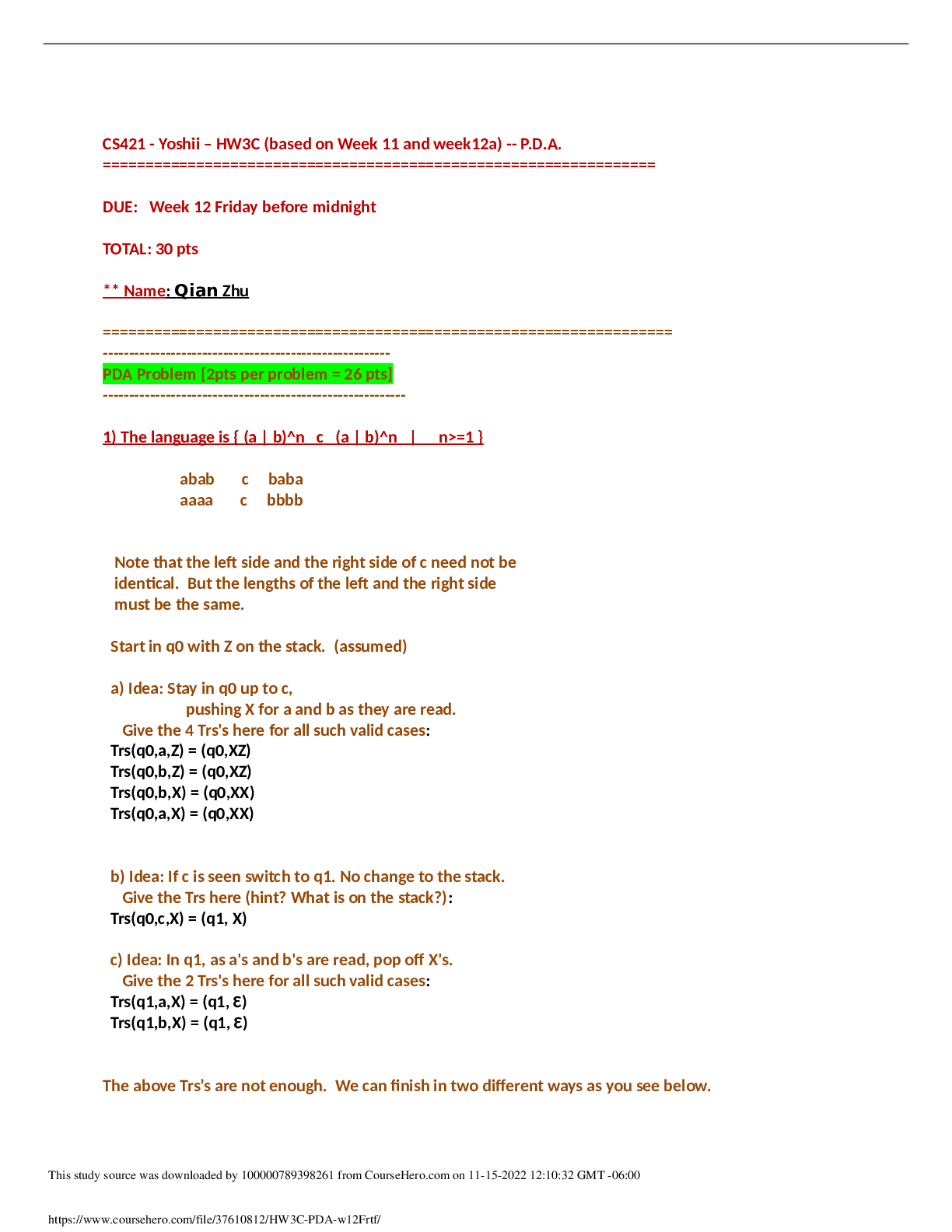


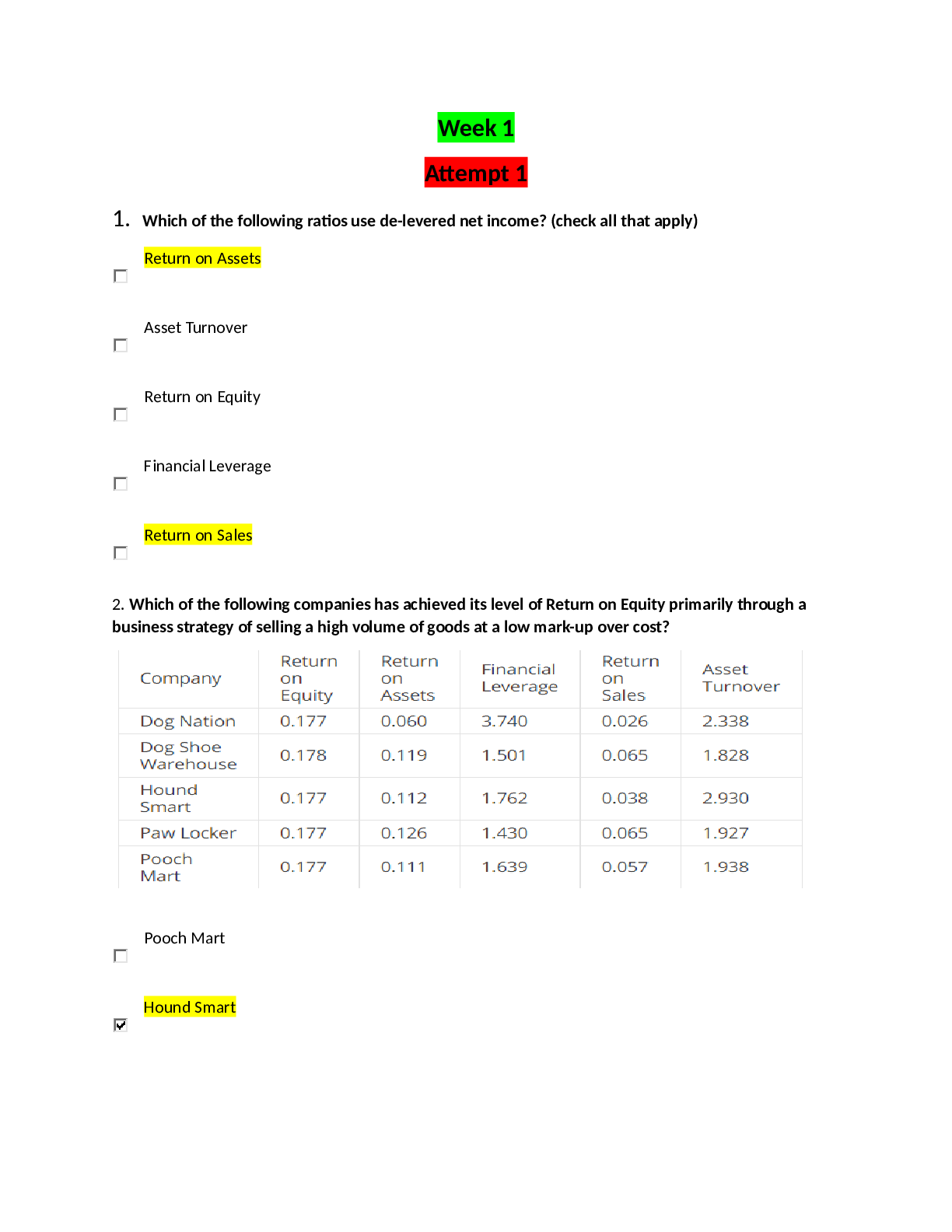
.png)
.png)
.png)
.png)
.png)
.png)
.png)
